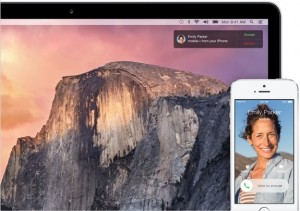Share This
Related Posts
Tags
Apple Pushes Continuity
By Anca Gagiuc on Jun 18, 2014 in Technology
SAN FRANCISCO – The 2014 Apple keynote, delivered here earlier this month, revealed some incredible updates for iOS and OS X, due this fall when the accompanying hardware will be unveiled.
The main theme this year is Continuity, which urges users to imagine how much better their digital life would be if the phone, tablet, and laptop all had the Apple logo. It’s now true that a superior operating system for laptop or smartphone performance is no longer sufficient. Apple is pushing the advantages of adopting a cohesive family of devices, hoping that current Apple users have no need to jump ship, and new converts are tempted to completely embrace the Apple culture. Why sell one device when you can sell two or three?
With continuity, the user can seamlessly start a task on one of the Apple devices (the iPhone, for example) and pick right where he/she left off to finish it on another device (the Mac), simply by clicking an icon that automatically appears. An iPhone owner with a Windows PC or a Mac owner with an Android phone won’t be able to do this.
OS X Yosemite & iOS 8
Since Continuity is the link between the two OSs, the majority of the updates apply to both. Actually, the latest version of OS X is reminiscent of last year’s iOS due to the attention spent on design. Flat design, translucent panels, no gradients, and textures of iOS 7 could be spotted throughout the new OS; app icons have flatter designs, the dock and windows have sharper corners, and a new system font was created for an improved readability. A “dark mode” that dims the entire interface was added to help focusing better while working – “clarity, but also utility”, as Senior VP Craig Federighi called it.
Spotlight – also known as Apple’s search feature, has not only become more prominent, with the search bar appearing in the center of the homescreen. Search scope has also been enhanced, with Spotlight searching for your results not only within your device, but also on the web. Another major change is that default web searches are no longer powered by Google, and are now run through Bing.
Mail – the native app has been modified to increase the users’ productivity – it now gives the ability to draft email by using a swipe down gesture, allowing you to check facts and details in other emails before tapping the message at the bottom of the screen to return to it and finish writing. Furthermore, within the Mail app, Mark Up has been added, which allows annotations to documents and files, as well as adding signatures simply by drawing on the trackpad. Further, the iCloud Drive service integrates all files stored in a user’s iCloud account into the Finder file browser where they can be organized into folders and receive tags like ordinary files. The iCloud Drive files will sync across Mac computers and even Windows PCs.
iMessages –expanded to include traditional text messages, and even Wi-Fi calling: users will be able to answer and place calls made with the iPhone on the Mac and use the Mac as a speakerphone. Moreover, new audio and video controls make it easy to record and send multimedia files.
Family Sharing – puts an end to all those large bills children gifted their parents through in app purchases. Family Sharing allows up to six family members to share information; when the child wants to download an app, the parent will be prompted for approval through a notification on their iPhone.
Photos – aside from the edit functions added to the iOS platform, the app lands on OS X Yosemite too. It is yet uncertain what will happen to iPhoto.
Notification Center – has been expanded with a new “today” view for calendar, reminders, weather, and can be extended even further with third-party app widgets.
Safari flaunts a cleaner design, less chrome, and improved search integration. Its integrated share menu now contains recent people messaged and RSS feeds, and a new tab view has been introduced that shows thumbnails of all open tabs. On top of these, Apple says that its browser now runs JavaScript code faster than any other browser out there.
Additionally iOS introduces the new predictive keyboard, something the Android users are already familiar with.
AirDrop between OS X and iOS is now supported, thus transfer of data between mobile devices and desktop is possible without cable.
Camera App – brings the option to adjust exposure and includes a self-timer option and a time lapse one, complimenting the existing Slo-Mo feature.
Siri – will integrate Shazam, the music recognition app, presenting a “buy” button whenever asked, to purchase it in iTunes. Moreover, Siri will offer hands-free assistance just by saying “hey, Siri”.
Touch ID will allow developers to authenticate their own apps (without getting access to the fingerprint data itself), so no more hassle with passwords and credentials. Apple now allows individual apps to talk to one another and exchange data.
